3D printing has become increasingly popular in recent years thanks to its affordability and ability to create complex and elaborated objects in the comfort of your garage. One of the most important decisions you’ll make when 3D printing is choosing the suitable filament, as the material you select will greatly affect the outcome of your project. With so many brands and options available on the market, it can be challenging to know where to start. This review will look closely at five filaments from Nanovia, suitable for drone parts.
Undoubtedly, 3D printing has also revolutionized how we create parts, components, and accessories for FPV drones. With the right filament, it is possible to produce lightweight, strong, and durable parts that can withstand the rigors of high-speed flight. Here are the most commonly used 3D filaments for FPV quadcopters:
- TPU (Thermoplastic Polyurethane): TPU is a flexible material ideal for creating drone parts that must withstand impacts and vibrations, such as camera mounts.
- PETG (Polyethylene Terephthalate Glycol): PETG is a strong and durable material that is ideal for creating parts that need to be lightweight and strong. PETG is considered a good middle ground between ABS and PLA and is suitable for internal rigid parts such as flight controller size adapters.
- Carbon fiber reinforced filaments (PLA CF, PA-CF, PC-CF, PP-CF, PEI CF, PETG CF, and ABS CF). CF filaments are composite materials formed by infusing carbon fiber fragments in polymer base 3D printing materials, such as PLA, ABS, PETG, PEKK, or PC, among others. CF-reinforced filaments are the most appropriate for 3D printing FPV drone frames.
Nanovia filaments: TPU 70D, PC CF, PETG GF, TPE 22D, and ISTROFLEX
Disclosure: I received these filaments as part of a product review collaboration with Nanovia Tech. Product specs and quality may vary according to the manufacturer’s reliability, so I cannot guarantee that you will get products that perform the same as seen in my article.
Based in Brittany region in France, Nanovia has been developing a premium range of composites, metal, and ceramic thermoplastic materials for aeronautical, naval, automobile, paramedical, and defense industries since its inception in 2014. They also provide various conventional filaments for 3D hobbyists, such as PLA, PETG, ABS, APA, PA, PC, PP, and PEI.
In addition to the TPU 70D and PC CF filaments, they included PETG GF, TPE 22D, and ISTROFLEX samples, and a bottle of Plast F10 waterproofing solution. All filaments were packed in the same type of recycled cardboard box. Nanovia also opted for environment-friendly cardboard spoolers. As it should be, the filaments were in airtight vacuum bags with small silica gel sachets inside.
Printing settings information (Nozzle, Plate, Enclosure temperatures, and Nozzle size) and manufacturing batch identification are stamped on the 200 x 53mm (diameter x width) bobbin. As the Cura slicing software does include Nanovia filament profiles, I need to create one for each type of material.
1. Nanovia TPU 70D semi-rigid filament
TPU, or Thermoplastic Polyurethane, is a rubber-like flexible and durable filament that can be used by hobbyists as well as in various industries across numerous applications. Due to the material’s softness is recommended to be used with a direct-drive extruder instead of Bowden-type machines.
Upon my request, they sent me two ‘native’ semi-transparent TPU 70D spools and one black bobbin. The filament has a 1.12 g/cm3 density and requires a 230 – 250 °C nozzle temperature, respectively, a print bed heated to 60 – 80 °C. The 500gr bobbin contains about 186 meters of filament.
With its shore hardness close to ABS (hard hat material) of 70D, Nanovia’s TPU allows semi-rigid functional wear-resistant structures that can regain their shape even from deformation caused by hard impacts. Furthermore, being UV resistant, it is suited for outdoor usage. With all these outstanding characteristics, many started using this filament to print Freezillion‘s epic RaceWhoop FPV drone. On Thingiverse, you can find many variations of this fantastic DIY project. I opted for a 2.5″ and a 3.5″ version. The TPU 70D is also a perfect material to print camera and antenna mounts for your FPV drone.
Being equipped with a direct-drive extruder, my Elegoo Neptune Pro worked with no issue using a 240°C nozzle and 70°C print bed temperatures. One 3.5-inch Whoop duct required about 47 grams (17.48m) of filaments with an estimated cost of 3.95€. By comparison, a similar ready-to-use duct can be found on eBay for $10. The translucent TPU is excellent for making a glowing drone with using a few RGB LEDs.
Nanovia TPU 70D technical specifications
| Mechanical proprieties | |
| Density | 1.12 g/cm3 (ISO 1183) |
| Traction resistance | 28 MPa (ISO 527) |
| Elong. at break | 320 % (ISO 527) Traction stress 100% elongation 20 MPa |
| Traction stress | 300% elongation 28 MPa (ISO 527) |
| Hardness | Shore 70 D |
| Diameter options | 1.75 & 2.85 mm (+/- 50 µm) |
| Color options | Translucid and Black |
| Thermal proprieties | |
| Operational T° | +/- 50 °C |
| 3D printing parameters | |
| Extrusion T° | 230 – 250 °C |
| Plate T° | 60 – 80 °C |
| Enclosure T° | 20 °C (room temperature) |
| Ventilation % | 0 |
| Printing speed | 20 – 70 mm/s |
2. Nanovia PolyCarbonate Carbon Fiber filament
Nanovia PC CF allows the creation of high-temperature (120°C) resistant pieces. This CF-reinforced polycarbonate filament is ideal for rigid functional objects, including drone frames.
I opted to test the Nanovia PC CF with the plan to print the frame (top and bottom plate) of the RaceWhoop. Unfortunately, I had too much confidence in the Elegoo Neptune 3 Pro printer. Its max 260°C nozzle and 100 °C plate temperature turned out to be too cold. The material didn’t stick to the PEI print sheet. According to Nanovia’s technical specs, their PC CF filament also requires heated enclosed machines besides the high nozzle temperature (260 – 290°C). As you can see in the image below, the filament has a beautiful metallic-black color. Toroidal propellers are making waves these days, and probably the Nanovia PC CF could be a suitable filament to 3D print them.
Nanovia PC CF technical specifications
| Mechanical proprieties | |
| Density | 1.26 g/cm3 |
| Young’s modulus | 6390 MPa |
| Ultimate strength | 87 MPa |
| Ultimate strength elongation | 2.7% |
| Diameter options | 1.75 & 2.85 mm (+/- 50µm) |
| Color options | Black |
| Thermal proprieties | |
| Tg | 120°C |
| HDT | 144°C ASTN D648 at 4.6 kg/cm2 133°C ASTN D648 at 18.6 kg/cm2 |
| 3D printing parameters | |
| Extrusion T° | 260 – 290°C |
| Plate T° | 100 – 140°C |
| Enclosure T° | 100°C |
| Nozzle | min 0.5mm |
| Special requirements | Dehydrate at 100 °C for 4 hours or more Nozzle for abrasive materials Room equipped with air extraction |
3. Nanovia Glass fiber reinforced PETG filament
Combining glass fibers, anti-UV additives, and PETG, natively waterproof and resistant to temperatures up to 80 °C, Nanovia PETG GF UV is the perfect filament for parts subjected to outdoor conditions.
Unlike carbon fiber-reinforced materials, glass fiber ones do not conduct electricity, which makes the PETG GF filament suitable for electrical applications. I found the filament easy to print during my tests, and the results were high-quality without cosmetic issues. I used the default PETG settings with no problems. The material seems durable enough to be used for the RaceWhoop’s top and bottom plate, but not for the frame of a 5″ racing quad.
Nanovia PETG GF technical specifications
| Mechanical proprieties | |
| Density | 1.42 g/cm3 ISO 1183 |
| Young’s modulus | 4284 MPa ISO 527/1A |
| Ultimate strength | 63MPa ISO 527/1A |
| Elongation ultimate strength | 2.3% ISO 527/1A |
| Diameter | 1.75 or 2.85mm (+/- 50µm) |
| Color options | White |
| Thermal proprieties | |
| Tg | 80°C |
| 3D printing parameters | |
| Extrusion T° | 220 – 240°C |
| Plate T° | 80 – 90 °C |
| Enclosure T° | 20 °C (room temperature) |
| Nozzle | minim 0.5mm |
| Drying | At 60 °C for 4 hours or longer |
4. Nanovia ISTROFLEX Biodegradable flexible filament
Nanovia Istroflex is a biodegradable flexible FFF filament (Shore 44D / 93A). Its flexibility is ideally suited for technical parts that require a certain amount of bounce, such as shock and vibration absorbers, gaskets, or mini tires for remote control cars. Another advantage of this material is that it doesn’t require special printing conditions. Unlike other filaments, it requires a low bed temperature (20 – 40 °C), which is electric bill friendly. To guarantee good printing conditions, dehydrate Nanovia Istroflex at 60 °C for 4 hours or more.
For test purposes, I printed some DJI AVATA prop guard protectors. I used a 210 °C nozzle and 30 °C bed temperature settings. The Nanovia ISTROFLEX bumpers ensure additional protection for collisions and crashes.
Nanovia ISTROFLEX technical specifications
| Mechanical proprieties | |
| Density | 1.55 g/cm3 (ISO 1183) |
| Traction resistance | 60 MPa (ISO 527) |
| Elong. at break | > 300 % (ISO 527) |
| Stress at break | 11.5 MPa (ISO 527) |
| Hardness | 93 Shore A, 44 Shore D |
| Diameter options | 1.75 & 2.85 mm (+/- 50 µm) |
| Color options | Cream and Black |
| Thermal proprieties | |
| VICAT | 91°C (ISO 306) 2.7 – 4.9 g/10min |
| MFR | 190°C 2.16kg (ISO 1133) |
| 3D printing parameters | |
| Extrusion T° | 210 – 230 °C |
| Plate T° | 20 – 40 °C |
| Enclosure T° | 20 °C |
| Nozzle | minim 0.4mm |
| Printing speed | 20 – 70 mm/s |
5. Nanovia flexible shock absorption TPE 22D filament
Nanovia TPE 22D allows the printing of flexible parts with excellent inter-layer adhesion. This material is easy to print and widely used for industrial shock and vibration absorption and pieces that need to deform dramatically. The TPE 22D is suitable for gimbal anti-vibration dampers.
Nanovia TPE 22D technical specifications
| Mechanical proprieties | |
| Density | 1.00 g/cm3 (ISO 1183) |
| Traction mod. | 12 MPa (ISO 527-1) |
| Hardness | 22 Shore D, 70 Shore A |
| Diameter options | 1.75 & 2.85 mm (+/- 50 µm) |
| Color options | Translucid |
| 3D printing parameters | |
| Extrusion T° | 220 – 240 °C |
| Plate T° | 30 – 50 °C |
| Enclosure T° | Room temperature |
| Nozzle | All |
| Printing speed | 20 – 60 mm/s |
Pricing, availability, and options
Nanovia offers most of its filaments in 500g and 2000g weight options. If you just want to test one of their materials, there are samples (30 meters) at a low price (5-10 euros). There is also an option for 1.75 or 2.85 diameters. When I published my review, the 500g TPU 70D was available for 42,00 €, and 2000 grams for 159,60 €. The PC CF has a price of 63,00 € for the 500g spool and 239,40 € for the 2000g bobbin.
For FDM printed parts, they have three post-treatment products:
- Sol Lis (Smoothing spray) – 29,40 €
- Plast F10 (Waterproofing solution) – 24,00 €
- Printer Bed Cleaner spray – 6,24 €
Made in France, Nanovia products are mainly available in European stores.

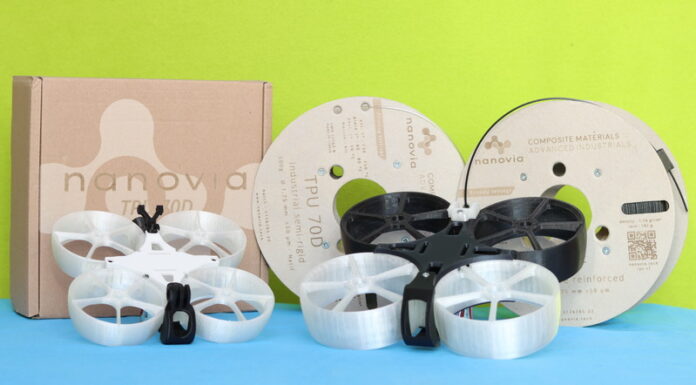
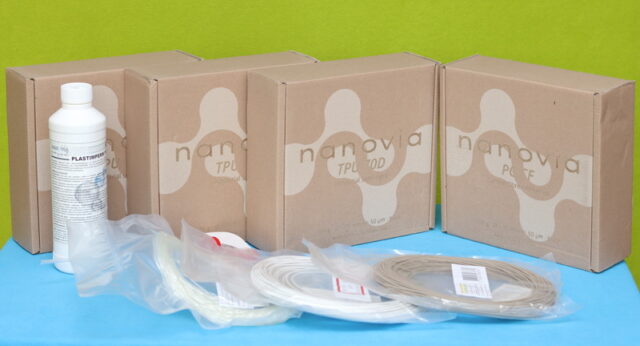
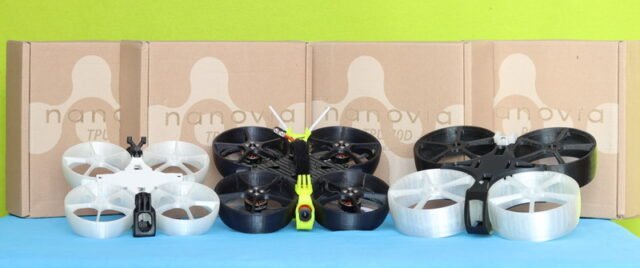
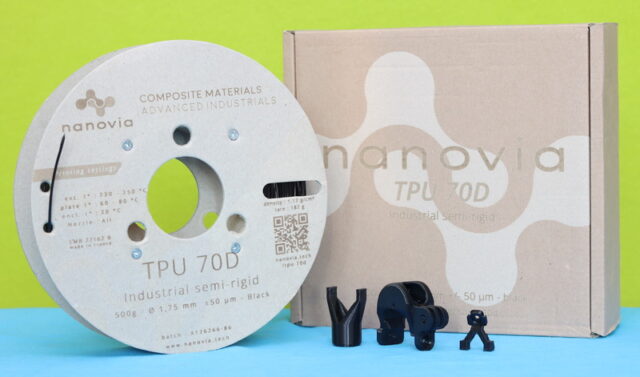
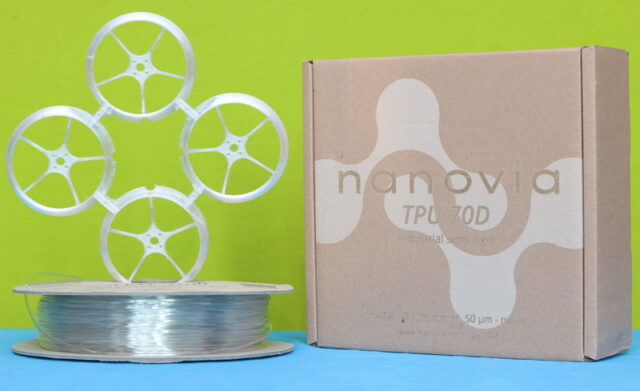

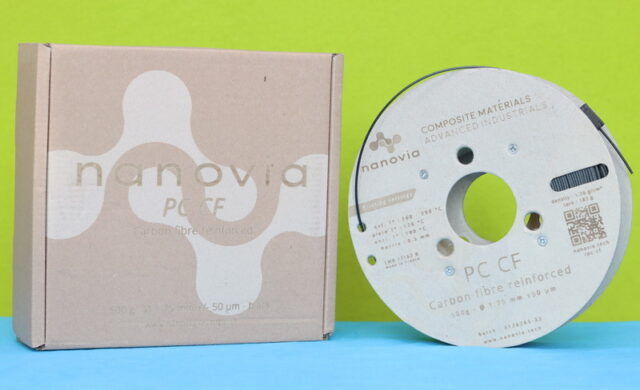
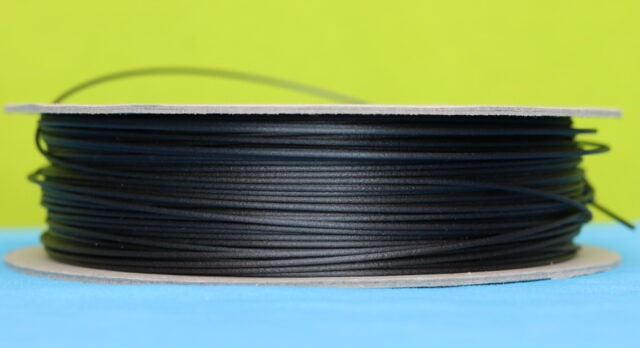
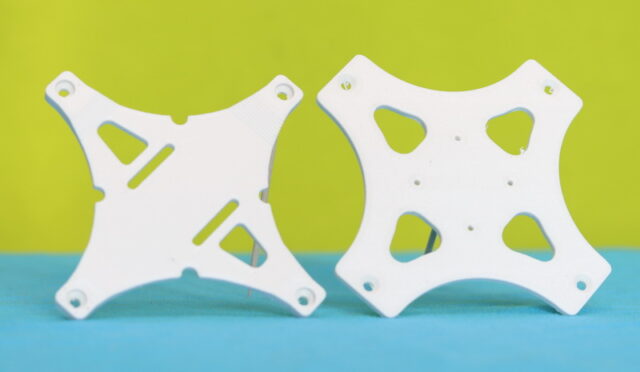
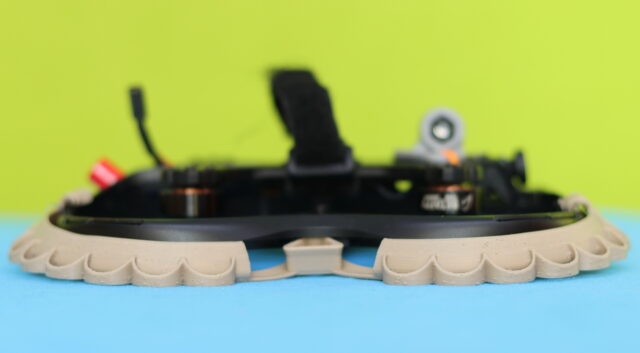
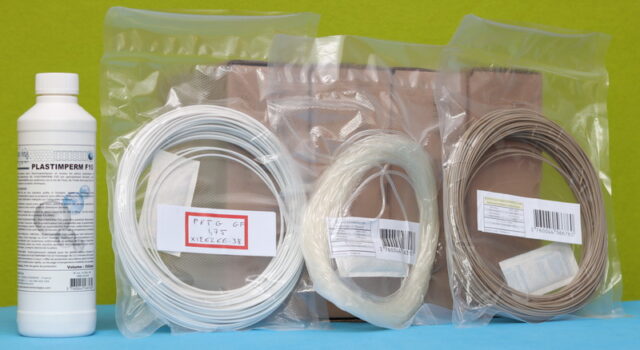
This Nanoia TPU works nicely on my ender-3 s1 pro. I am new to 3D printing still, and this was my first time with TPU and I had no issues whatsoever. I just followed your temperature instructions and had great results for the first time using flexible filament.
This is the only TPU I’ve printed with. It has great quality, perfect for camera mounts and other wearing-resistant parts.
How are these compared to OVERTURE TPU? I don’t know which would be a better option for a 2.5″ RaceWhoop
Nanovia TPU filament is durable and easy to use material that is ideal for printing flexible and elastic drone parts.